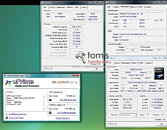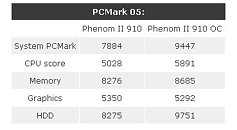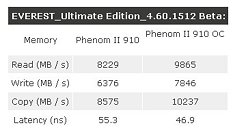Saturday, January 24th 2009

First AMD Benchmarks With DDR3 Memory Posted
Better late than never, AMD is embracing the DDR3 memory standard. Its newest desktop CPU socket, the AM3, connects the processor to dual-channel DDR3 memory. Initial specifications about AMD's processors on the new socket suggest that DDR3 1333MHz (PC3-10600) will be held as the memory standard the integrated memory controllers on AMD's processors support. The far-east team of Tom's Hardware posted the first series of benchmarks of a Phenom II AM3 processor, when paired with DDR3-1333. The benchmarks featured Gigabyte's MA790FXT-UD5P motherboard along with Corsair's dual-channel DDR3-1333 kit running at DRAM timings of 9-9-9-24. The CPU-Z window also shows that the memory modules are running unganged, meaning that the two memory controllers of the Deneb core are independent, with each controller handling a 64-bit wide memory channel. This state is somewhat comparable to that of single-channel memory, except that multi-threaded applications will still be able to independently address memory on each channel, utilizing all the bandwidth on offer.
At the center of the test-bench was the AMD Phenom II X4 910, the company's first flagship quad-core AM3 processor. The X4 910 features a default clock speed of 2.60 GHz. The same chip was tested in two settings: default clock-speeds, and overclocked to 3.12 GHz (240 x 13.0 @ default vCore). The screenshots below show the test results for WPrime. The overclocked chip scored a crunch-time of 46.613 s (1M). The overclock did not affect SuperPi at all, with insignificant differences in the scores between the two. PC Mark 05 got a decent boost, while 3DMark06 didn't. Memory bandwidth and latency tests showed something strange, with the overclocked CPU (in effect memory) turning up with lesser latency (while normally, increase in clock speeds tend to step up latencies). The tests show that there are increments in performance with the use of DDR3 memory, though they are merely proportional to the clock speeds the memory is running at.
Source:
Tom's Hardware
At the center of the test-bench was the AMD Phenom II X4 910, the company's first flagship quad-core AM3 processor. The X4 910 features a default clock speed of 2.60 GHz. The same chip was tested in two settings: default clock-speeds, and overclocked to 3.12 GHz (240 x 13.0 @ default vCore). The screenshots below show the test results for WPrime. The overclocked chip scored a crunch-time of 46.613 s (1M). The overclock did not affect SuperPi at all, with insignificant differences in the scores between the two. PC Mark 05 got a decent boost, while 3DMark06 didn't. Memory bandwidth and latency tests showed something strange, with the overclocked CPU (in effect memory) turning up with lesser latency (while normally, increase in clock speeds tend to step up latencies). The tests show that there are increments in performance with the use of DDR3 memory, though they are merely proportional to the clock speeds the memory is running at.








75 Comments on First AMD Benchmarks With DDR3 Memory Posted
EDIT: Ok I've just read that xtreme systems link, it explains it all.
As far as DDR3 prices vs DDR2 prices go - it depends on what kind of, and what performance segment, DDR3 you want to buy.
If you're looking for the el-cheapo, off-the-shelf-at-Best-Buy, not going to OC or hope it runs stable -type of DDR3:
< $25
if you want something cheap, that should be fairly reliable:
< $50
if you're looking for the low-end performance market:
< $100
and the price of more higher-end performance DDR3 is on par with what high-end DDR2 was only a year and a half or so ago.
Even still, one can purchse 2GB of high-end DDR3 at prices comparable to high-end DDR2.
It's time to start putting some of these myths to rest :toast:
the timings are so bad on them
they will get better just like ddr 2 did but right now the speed vs timings is BAD
Just to break it down in a very general way, running timings of CAS8+ with DDR3 doesn't mean squat when the memory is capable of moving nearly twice the amount of information that DDR2 is capable of, per clock cycle.
Think of it like this, DDR2 moves information like a garden hose. DDR3 moves information like a firehose.
Think of timings like kinks in the hose, how many kinks can you add to a gardenhose before it starts to hurt overall performance? How many kinks can you add to a firehose before it hurts overall performance?
DDR2 benefits from getting all those kinks out. Sure, you can increase the volume moving through the hose by increasing the pressure (think: clock speeds), but after a certain point, it just can't do any better without possibly bursting the hose. DDR3, on the otherhand, being a firehose, can handle much more volume and pressure (think: clock speeds) without having to iron out all the kinks (high latency timings).
im not on tpu as much due to lack of wireless on main rig, thats why i aint been involved in any recent discussions like ddr3 and phenom 2
People want to know the difference between DDR3-1600 at CL9 vs DDR3-1600 at CL7 when using AM3, for example. You really can't compare DDR2 timing to DDR3 since we know that DDR3 is faster (1600MHz for example). Only a well thought out review can fill in missing pieces of this puzzle. Time will tell (hopefully).
as velocity increases, pressure decreases, as pressure increases, velocity decreases
venturi effect
en.wikipedia.org/wiki/Venturi_effect
now with electrons, since apparently they move at speed of light without control, latency and Clock speed manage the flow of electrons thru the system (Local Oscillator), because just like how EM rays are emitted into space, once they hit space (either beyond our atmosphere or within) they are moving at speed of light, once they hit the pickup they are slowed down, aka Radio transmit towers and Radio receivers in cars.
DRAM latency is brought about by the way the SPD is programmed, on how it makes the IMC/MCH deal with the memory (based on the SKU and quality of the DRAM chips used). higher latency = more number of clock-cycles spent in moving data across. The reason you don't have 800 MHz (1600 DDR) do CL 2T is because of the high clock speed, and the constraints/limitations brought about by the DRAM technology with respect to the chips' voltages and thermal footprints. The high clock speed makes up for the latency, though for PC3-10600 (1333 MHz), the ideal latency should be 6-6-6-~18. The latest generation of DDR3 kits haven't managed to do those latencies at sub-1.6V, owing to the silicon fab technology they're built on, and hence we're seeing 1333 MHz kits with 9-9-9-~24, which isn't all that great compared to 1066 MHz at 5-5-5-~15.
i get 13.638sec seconds with my setup
i know i have 4gb of ram while that setup only had 2gb...but still....
yeah, I know all that physics stuff - but I was trying to keep it on a technical level most would be able to understand :toast:
Josh
The CPUZ picture says it is a AM2+ socket mobo, but on THS and Gigabyte site says it is a AM3 - www.tomshardware.tw/image/GA-MA790FXT-UD5P-01,0101-176917-5623----jpg-.html . There are something not right here.
With one thread my system did 46,562s.
CPU 3.2GHz, NB/HT 2.4GHz, RAM 1066 5-5-5-15